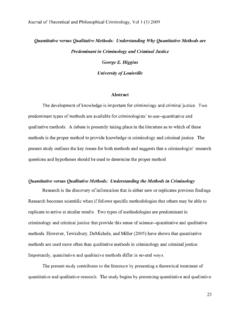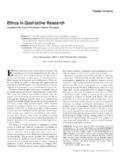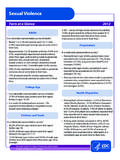Transcription of PRO-SOCIAL MODELLING Abstract - ejprob.ro
1 142 European journal of Probation University of Bucharest Vol. 1, No. 2, 2009, pp 142 152 ISSN: 2006 2203 PRO-SOCIAL MODELLING Chris Trotter Associate Professor Monash University Abstract PRO-SOCIAL MODELLING is increasingly becoming recognised as a key skill in the supervision of offenders. This paper defines PRO-SOCIAL MODELLING , discusses the research support for its use and describes the way it can be implemented in a criminal justice setting. It goes on to discuss the relevance of worker empathy and the perceived legitimacy of the worker. The strengths and weaknesses of PRO-SOCIAL MODELLING are identified and some of the criticisms of the model are discussed.
2 Finally the extent to which PRO-SOCIAL MODELLING can be taught is considered. Keywords: Effectiveness - PRO-SOCIAL MODELLING Probation Probation Officers Introduction What is PRO-SOCIAL MODELLING ? The term PRO-SOCIAL MODELLING in its most limited sense refers to the way in which probation officers, or others who work with involuntary clients, model PRO-SOCIAL values and behaviours in their interactions with clients. The term is however often interpreted more broadly to include a group of skills which include supervisors MODELLING PRO-SOCIAL values, reinforcing client s PRO-SOCIAL expressions and actions and negatively reinforcing or confronting pro-criminal actions and expressions of those clients.
3 The term PRO-SOCIAL practice or PRO-SOCIAL model is also often used by practitioners to describe a still broader approach to the supervision of offenders which includes collaborative problem solving and role clarification (see Trotter 1999, 2004). In this article I am using a definition of PRO-SOCIAL MODELLING which includes MODELLING , positive and negative reinforcement and confrontation. This paper is based on a chapter published in McIvor G & Raynor P (2007) Developments in social Work with Offenders Jessica Kingsley, UK 143 Research on the PRO-SOCIAL model The importance of PRO-SOCIAL MODELLING in the supervision of offenders has been shown in studies as early as 1964.
4 Robert Martinson and his colleagues (1975) in their now famous (or infamous) study on what works in corrections refers to a study by Schwitygebel published in 1964 which found reduced numbers of arrests and incarcerations, compared to a matched control, among young offenders who were given positive reinforcement for successful accomplishments. For example they were rewarded with cash for attending sessions and talking in detail about their experiences. Subsequent studies using PRO-SOCIAL MODELLING and reinforcement found similar outcomes ( Sarason and Ganger 1973, Fo and O Donnell 1974, 1975).
5 Don Andrews and his colleagues (1979) examined tape recordings of interviews between Canadian probation officers and their clients and found that probation officers who modelled and reinforced PRO-SOCIAL values and who also made use of reflective listening practices had clients with lower recidivism rates in comparison to other probation officers. Probation officers who scored above the mean on a Socialisation scale (a measure of PRO-SOCIAL orientation) and an empathy scale (a measure of workers understanding of other s point of view) also had clients with lower recidivism.
6 I found in a study undertaken in Australia (Trotter 1990) that volunteer probation officers had clients with lower recidivism if they scored above the median on the socialisation scale regardless of the levels of empathy of the clients. In other words PRO-SOCIAL officers did better. A later study (Trotter 1996) which again replicated aspects of the Andrews et al (1979) study found that professional probation officers also did better when they had high levels of socialisation and when their file notes indicated that they the reinforced PRO-SOCIAL expressions and actions of in their clients.
7 This again was regardless of empathy levels. A similar study (Trotter 2004) found that child protection workers, who in many cases work with young people and families who are involved in the criminal justice system, did better on a range of outcome measures, including client and worker satisfaction with outcome and earlier case closure, if they used the skills of PRO-SOCIAL MODELLING and reinforcement and appropriate confrontation. The value of PRO-SOCIAL MODELLING in the supervision of offenders has been further demonstrated in meta-analysis undertaken by Don Andrews and James Bonta (Andrews et al 1991, Andrews 2000, Andrews & Bonta 2003, Bonta 2004).
8 How do workers model PRO-SOCIAL values ? The Gough socialisation scale which was used in the Andrews et al study (1979) and my studies (Trotter 1991, 1996) places individuals on a continuum from PRO-SOCIAL to pro-criminal behaviours and forecasts the likelihood that they will transgress mores accepted by their particular culture (Megargee 1972). The scale was originally developed as a delinquency scale. It reflects a person s, social maturity, integrity and rectitude . It reflects family cohesiveness, social sensitivity, empathy, optimism and self confidence (Megargee 1972).
9 144 How do people who score high on the scale behave in comparison to those who score low on the scale? In both the Canadian and Australian studies those who scored high on the scale were more likely to model and to express views which support the value of a law abiding lifestyle. Some examples of the practice of PRO-SOCIAL MODELLING are set out below. These are based on my studies in corrections and child protection (Trotter 1996, 2004) and on comments from participants in many seminars I have undertaken with professional workers examining the process of PRO-SOCIAL MODELLING .
10 PRO-SOCIAL modeling involves the worker keeping appointments, being punctual, honest and reliable, following up on tasks, respecting other people's feelings, expressing views about the negative effects of criminal behaviour, expressing views about the value of social pursuits such a non-criminal friends, good family relations and the value of work. It involves interpreting peoples motives positively "most police are people trying to do a job and they have similar needs to most of us" rather than "all police are pigs . It involves being open about problems the worker may have had which are similar to the offenders "I spent a period of time unemployed at one time and I found it depressing".





